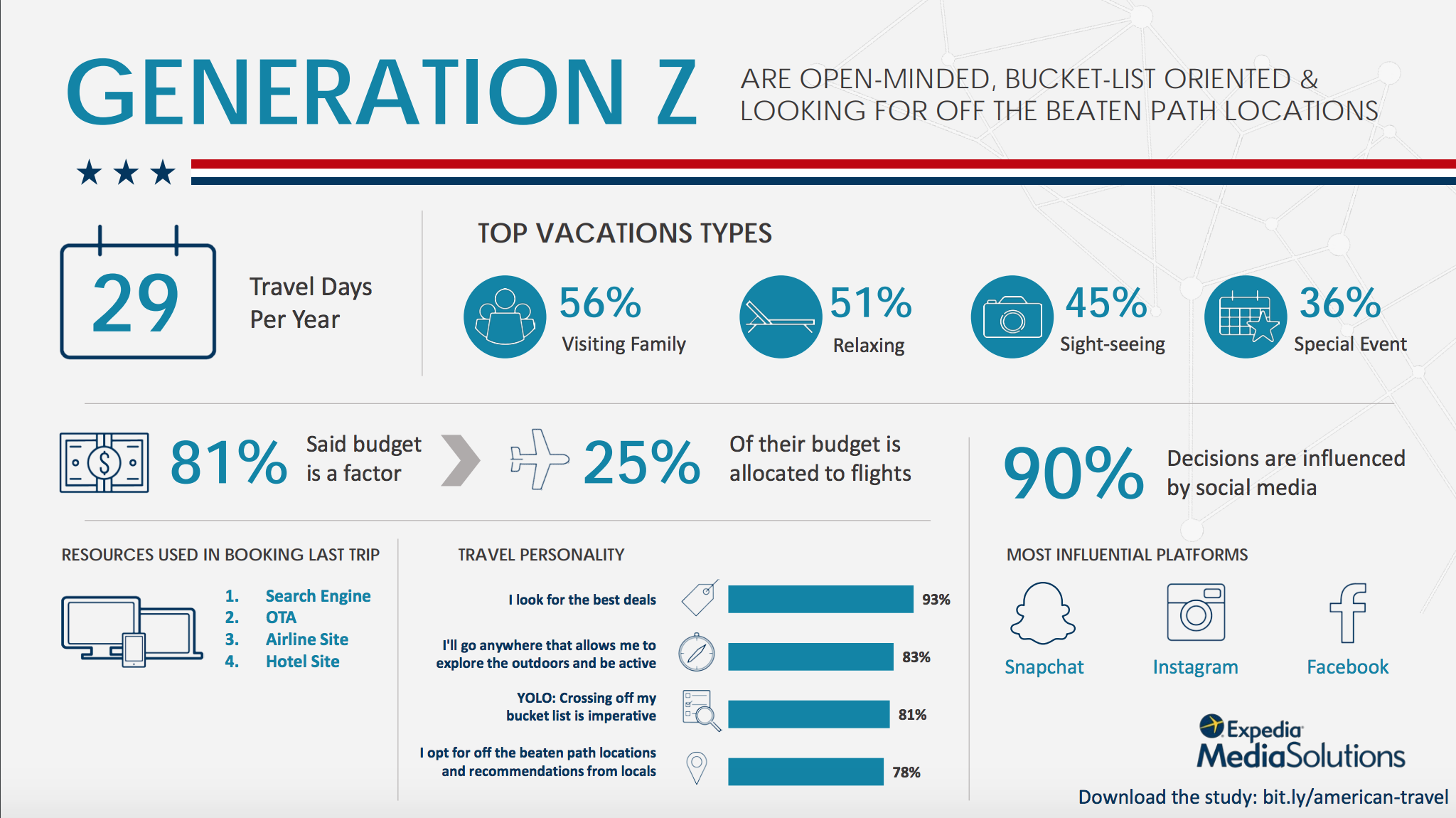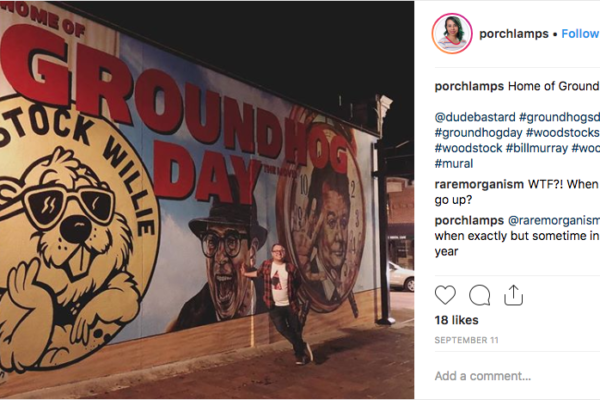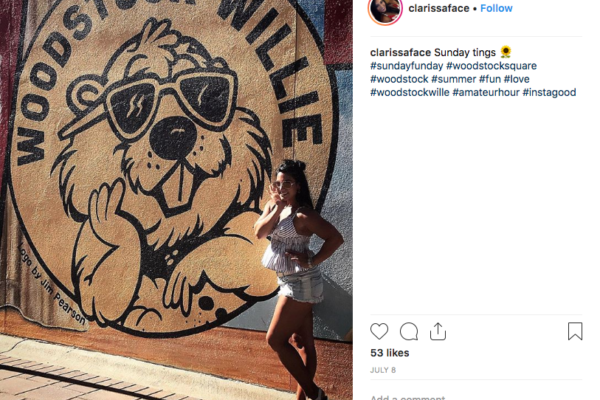Globetrotting, off-the-beaten-path-seeking, social-media-loving Generation Z travelers. They’re picture perfect cheerleaders. Which is why DMOs are clamoring for their attention.
Born starting around 1996, Gen Z is defined less by age and more by the events that shaped their early lives. And the biggie here, obviously, is the digital revolution. Whereas Millennials are “digital pioneers,” remembering a time before technology infiltrated every aspect of their lives, members of Generation Z are digital natives—they’ve never known anything but smartphones and social media, and they’re entirely defined by their use of technology.
The obvious question is, why focus so much attention on a generation that’s still in its teens and early 20s, potentially without the financial independence to book a trip?
The idea that Gen Z lacks influence and purchasing power is a dangerous one. In fact, Gen Zs have a big say in family travel planning and purchasing decisions—with a super generous mom and dad happily handing over their credit cards to make it all happen.
And another thing; while Millennials travel the most—35 days a year, according to an October 2017 traveler poll conducted by Skift—Generation Z is close behind, booking 29 days of travel— basically an entire month—out of every year. Here’s just a snapshot of their travel behavior:
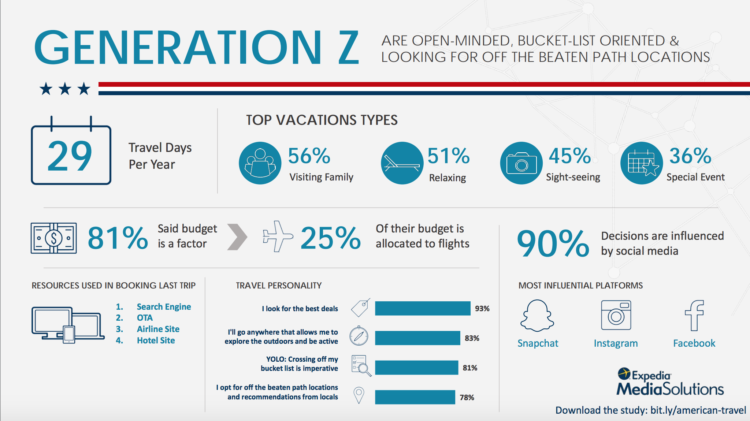
To capture the imaginations of Gen Z travelers, though, you need to understand what motivates and engages them—and how to make those traits your greatest marketing assets.
6 ways to prime Gen Z as your greatest brand ambassadors
1. Understand that peer-to-peer insights are a really big deal
Social media plays a huge role in informing and influencing Gen Z travelers. In fact, according to Skift’s study, 90% of travel decisions are influenced by social media, with Snapchat and Instagram at the top of the influencer list.
True enough, Gen Z lives and breathes social media. Which is why content like “The 10 Best Summer Selfie Spots” and “10 Instagram-Loving Fall Locations” are invariably such a hit, inspiring travelers to visit, photograph, share, and comment.
That last part is particularly important. Gen Z can see a sales pitch a mile away. Ryan Gosling wooing the camera with sultry endorsements isn’t going to cut it. Gen Z gravitates towards authenticity over hype, steering clear of content that is blatantly the brainchild of a team of marketers.
Which is why it’s so important to share user content, putting the focus squarely on peer-to-peer reviews—the only reviews worth a damn in the minds of Gen Z.
It’s so important to share user content, putting the focus squarely on peer-to-peer reviews—the only reviews worth a damn in the minds of Gen Z.
As Ad Age explains in its report “Meet Gen Z: The Traveling Generation, “Gen Zers aren’t merely frequent fliers when it comes to vacation—they’re frequent posters, sharers and tweeters on social media as well. Broadcasting their travels on Instagram and similar networks not only reaffirms their own sense of self, it also lets them build their own personal brands and become micro-influencers among their peers.”
But friends’ posts and reviews aren’t the only thing Gen Zs are looking to for travel inspiration. Digital influencers play a big part, helping travel brands to tell a unique story that is singularly relevant to the influencer’s expansive list of followers.
Take, for example, Jane Ko’s guest blog for Choose Chicago, one of three digital influencers engaged to raise awareness of the unique experiences, food, and drinks Chicago has to offer to inspire travelers to consider the city as a destination. Ko, the woman behind A Taste of Koko®, Austin’s top food and travel blog, boasts 50,000 followers on Instagram alone. Not surprisingly, then, her coverage of “13 Best Chicago Restaurants You Have to Eat at” played a significant role in achieving the campaign’s astounding 2.1M earned reach, 490% over its original 36,000 goal.
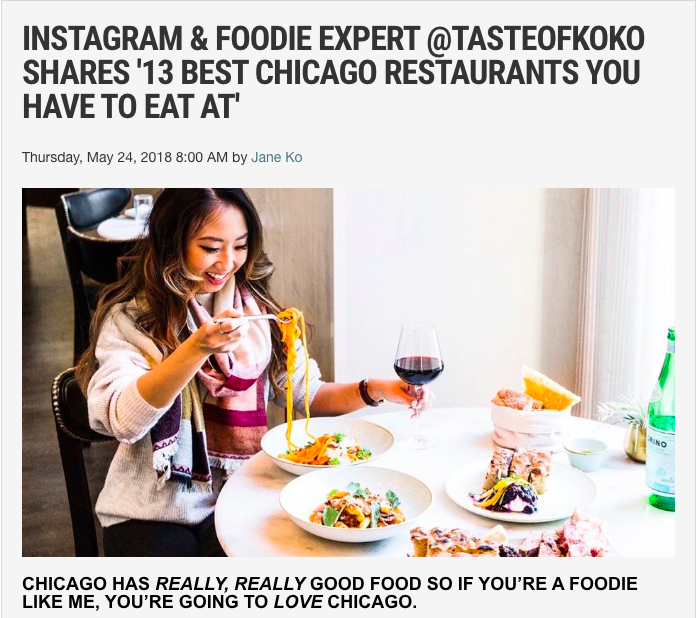
2. Put the focus on all things unique and adventurous
Gen Z, more than any other generation, is looking for singular destinations and experiences, from unique or alternative accommodations to out-of-the-ordinary attractions and events.
Not surprisingly, then, outdoor adventure is a big lure. In fact, Skift’s study reveals that open-air recreation is a top priority for Gen Z, with 83 percent quoting the ability to explore outdoors and be active as a major factor in favoring one destination over another.
That’s not to say it’s all about jogging up a mountain. Gen Zs are, in fact, rather sophisticated travelers, with a strong desire for cultural experiences. Back to Skift, 51% of respondents indicated that relaxing is a primary purpose of traveling, with sightseeing (45%) and special events (36%) following closely behind.
What’s more, Gen Zs are always-on travelers. They travel consistently throughout the year, meaning that while some brands are age group specific, travel brands could very well span a lifetime.
Another point to bear in mind: Gen Zs would much rather “wing it” when they travel, rather than planning every hour of every day. Because they’re so spontaneous, itineraries simply don’t resonate with them.
3. Deliver experiences that are Instagrammable & Snapchatable
Gen Zs share as much on social media as they consume. And for this generation, sharing social media content is synonymous with the travel experience. Along the entire travel timeline—posting about potential destinations, sharing real-time posts while there, and reminiscing once back—Gen Zs are often unwittingly boosting their brand ambassador status, cheerleading for your city.
DMOs get this. Which is why cities as huge as LA and as small as Woodstock, Illinois have become photo op meccas. With a population of just over 25,000, the tiny city of Woodstock, for example, unveiled its “Woodstock on Film and on The Stage Mural” and sculpture garden in the Main Street Pedway last year.
The mural celebrates everything from Orson Welles and Dick Tracy to Planes, Trains and Automobiles and, perhaps most famously, 1993’s Groundhog Day. In the words of councilman Terry Willcockson, the public art was intended as a “huge tourist attraction,” a place for visitors to come, take selfies against iconic faces and explosive color, and comment on how cool it all is. In other words, a way to create a culture of brand ambassadorship—no sales pitch needed.
4. Appeal to their sense of wanderlust
Gen Z has grown up with Instagrammable adventures, telling the thrilling stories of destinations the world over. So it’s really no surprise that Gen Zs are filled with a sense of wanderlust, with no destination too far-flung to venture to.
Travel designer and Recommend contributor Susan Farewell explains that, “Gen Z’s parents got them a passport when they were born. They’re growing up with friends around the world and it’s expected that many study abroad (or will study abroad)…multiple times. This generation is also motivated to understand the world more, to build bridges, to help with world problems. There is a real passion for traveling and a natural tendency to think and live globally.”
As such, don’t underestimate the interest international Gen Z travelers might have in rallying the family to visit your city. With the world seeming all the more accessible to them thanks to social media, they’re all the more likely to embrace the idea of international travel.
5. Get in on their bucket list mentality
Sure, they’re in their teens and early 20s, but Gen Zs have a strong sense of life being short and needing to be lived to the fullest. They’re also an aspirational lot, who value experiences far more than materialistic pursuits. Which means that travel most likely will play a major role not just now, but throughout their adult lives.
In terms of how to engage that bucket list mentality, it’s really all about adventure, uniqueness and immersion. Gen Zs won’t necessarily fill their bucket lists with things like “take a walking tour around Chicago,” “have brunch at Macy’s on State Street” or “check out T-Rex fossils at the Field Museum.” But they might very well fill it with things like “take a helicopter tour over Chicago’s skyscrapers,” “go to the World Famous Gospel Brunch at House of Blues” or “sleepover with T-Rex at the Field Museum.”
In terms of how to engage that bucket list mentality, it’s really all about adventure, uniqueness and immersion.
6. Make visiting your city worth the money
Again according to Skift, 81 percent of Generation Z says budget is a major factor in making destination decisions, with 25 percent of that budget going to air travel. What’s more, 93 percent look for the best deals out there—whether cheap tickets, budget hotels, food and drink specials, or free and cheap tours and attractions.
Promo codes and packages shared across social media, as well as content that stresses free and cheap things to do, therefore are most likely to engage and motivate Gen Z travelers, converting them into bona-fide visitors. Exclusive student deals are also a great idea, calling out to Gen Z travelers like a megaphone.
Which deals resonate the most? According to AdAge’s report, the top three are airfare (16.6%); hotels, hostels and lodgings (17%); and travel package deals (14.5%). All-inclusive getaways (12.7%) and excursions, tours and adventures (10.5%) follow closely behind.
That said, as the report points out, 69% of respondents described their travel style as “affordable with the occasional splurge.” Don’t make it all about bargains. And if you’re recommending a splurge, it better be off-the-beaten-track and supremely unique.
Though teenagers and young adults, Gen Zs are extremely influential in cultivating brand loyalty and swaying purchasing decisions in the travel space. Their trust of social media referrals and digital influencers, coupled with their penchant for extraordinary experiences opens up a slew of creative possibilities for DMOs worldwide, all leading to the ultimate goal of capturing the hearts, minds and loyalty of this rising generation not just now, but for a lifetime.

